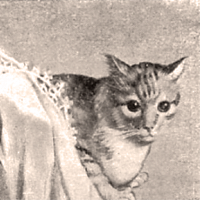
Chiara Vigo from Sant'Antioco, Sardinia has sworn an oath to protect and continue the art of Byssus making. She has studied how to collect the Byssus without harming the animal that makes it. She takes her oath very seriously and seeks to safeguard the source of Byssus as well as educate people about it. Much of what she has learned was passed down from her grandmother.
One Pinna Noblis produces 10 grams of raw Byssus per year. The raw Byssus can only be collected once a year in a very small window of time. 10 grams of raw Byssus becomes only 1 gram of thread.

Once the Byssus is brought on land, it is soaked in freshwater for 25 days. This water must be continuously changed day and night until there is no more salt in the water. The Byssus is then left to dry in the shade. When it is completely dry it is cleaned and combed. This process takes several hours and then the filaments are extracted, collected and transferred to a small spindle made of juniper wood, wound on by hand. The Byssus thread is now ready to be handwoven into a piece of fabric mounted on a frame.
There is a 38 minute interview with Chiara Vigo here under the heading: Sant'Antioco, intervista a Vigo Chiara (Video). It is in Italian and Sardinian dialect. If you have the patience however at 29:40 (29 minutes and 40 seconds in) she demonstrates how to make the thread and weave it.
See some of Chiara's works here (click on the photos for a closer look).
Historically Byssus was used largely as accents for ecclesiastical items or for royalty. It was never in mass production to produce items for sale. Sardinia has always woven its Byssus while Taranto used it also for other things like knit fabrics or for embroidery. Taranto, in the south of Italy, produced Byssus in antiquity. The Smithsonian Museum has a Byssus glove probably woven in the late 19th century in Taranto:

There is an historical article in English with photos here.
Today fabrics are produced in Italy for embroidery which are called Byssus (Bisso in Italian) but they do not contain any of the Pinna Noblis filaments. They are high count linens and quite transparent. Perfect for Shadow work embroidery on curtains!
Images taken from Wikipedia, thanks to John Hill.





Ciao Jeanine io conosco personalmente chiara e quando verrai in Sardegna ti porto a conoscerla. Ciao qui fa un caldo da morire 40°!!!!!!!!!!!
ReplyDeleteCiao da Elisabetta
Ooh che bello! Spero tanto di trovare un bel po' di tempo di passare con voi. La Signora mi sembra appassionatissima... mi sono commossa guardando il video!!
ReplyDelete(qui abbiamo solo 16 gradi oggi)
Ciao!
Thankyou ! Today I truly learned something ne ! Chiara's video is so interesting ! Thankyou for sharing .
ReplyDelete